 |
YIELD TO MATURIRY:Current Yield, Holding Period Returns |
| << BONDS & BONDS PRICING:Zero-Coupon Bonds, Fixed Payment Loans |
| SHIFTS IN EQUILIBRIUM IN THE BOND MARKET & RISK >> |
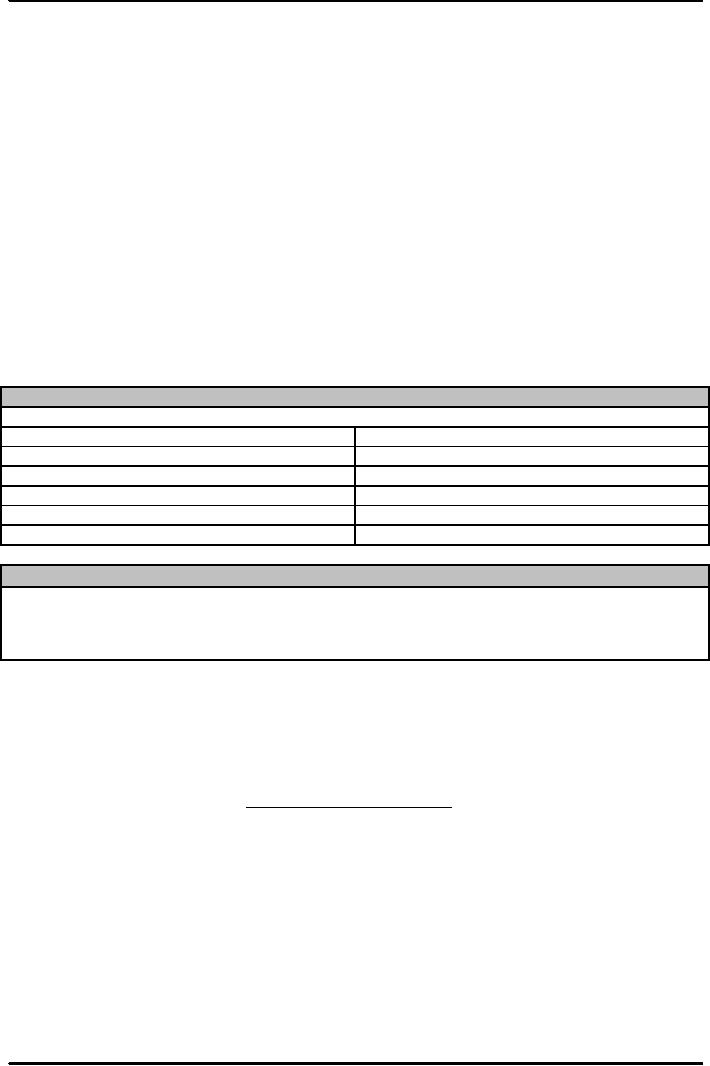
Money
& Banking MGT411
VU
Lesson
14
YIELD
TO MATURIRY
Yield
to Maturity
Current
Yield
Holding
Period Returns
Bond
Supply & Demand
Factors
affecting Bond Supply
Factors
affecting Bond Demand
Yield
to Maturity: General
Relationships
General
Relationships
If
the yield to maturity equals the coupon
rate, the price of the bond is the same
as its face value.
If
the yield is greater than the coupon
rate, the price is lower;
if
the yield is below the coupon rate, the
price is greater
If
you buy a bond at a price
less than its face
value you will receive
its interest and a capital
gain,
which is the difference between the price
and the face value.
As
a result you have a higher
return than the coupon
rate
When
the price is above the face
value, the bondholder incurs a capital
loss and the bond's
yield
to
maturity falls below its
coupon rate.
Table:
Relationship between Price and Yield to
Maturity
YTM
on a 10% Coupon rate bond maturing in
ten years (Face Value =
$1,000)
Price
of Bond ($)
Yield
to Maturity (%)
1,200
7.13
1,100
8.48
1,000
10.00
900
11.75
800
13.81
Three
Interesting Facts in the above
Table
1.
When
bond is at par, yield equals
coupon rate
2.
Price
and yield are negatively
related
3.
Yield
greater than coupon rate
when bond price is below par
value
Current
Yield
Current
yield is a commonly used, easy-to-compute
measure of the proceeds the
bondholder
receives
for making a loan
It
is the yearly coupon payment
divided by the price
Yearly
Coupon Payment
Yield
=
Current
Price
Paid
The
current yield measures that
part of the return from
buying the bond that arises
solely from
the
coupon payments;
It
ignores the capital gain or loss
that arises when the bond's
price differs from its
face value
Let's
return to 1-year 5% coupon
bond assuming that it is
selling for $99.
Current
yield is 5/99 = 0.0505 or
5.05%
YTM
for this bond is calculated
to be 6.06% through the following
calculations
43
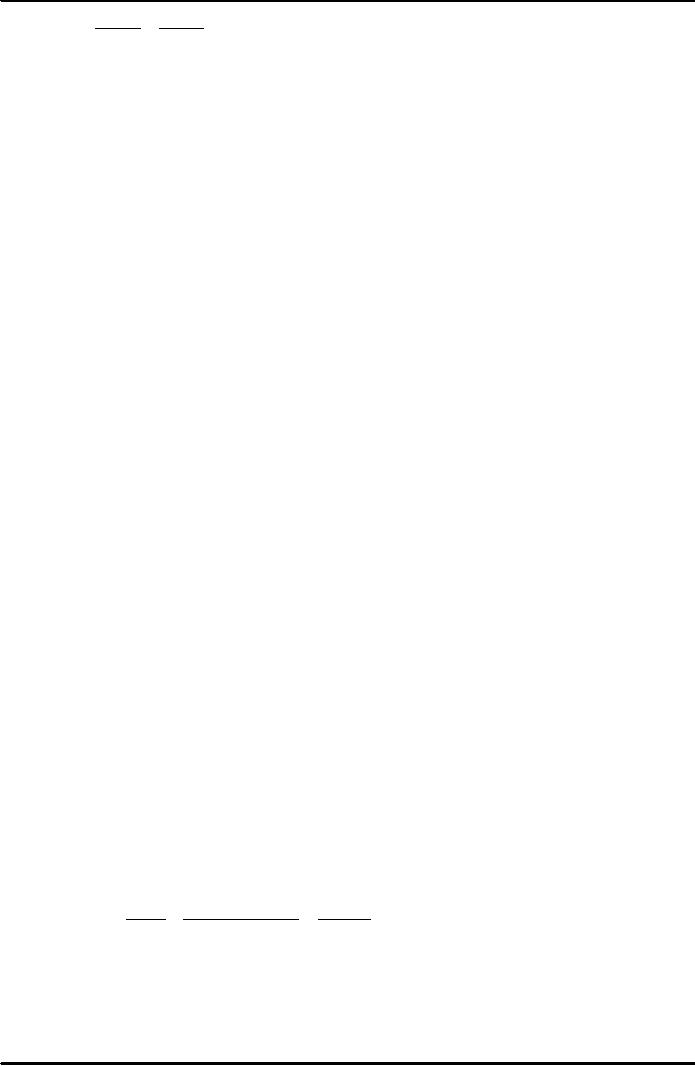
Money
& Banking MGT411
VU
$5
$100
+
=
$99
(1
+
i)
(1 +
i)
If
you buy the bond for
$99, one year later you get
not only the $5 coupon
payment but also a
guaranteed
$1 capital gain, totaling to
$6
Repeating
this process for the bond
selling for $101, current
yield is 4.95% and YTM is
3.96%
The
current yield moves
inversely to the price;
If
the price is above the face value, the
current yield falls below
the coupon rate.
When
the price falls below the
face value, the current
yield rises above the coupon
rate.
If
the price and the face value
are equal the current yield
and the coupon rate are
equal.
Since
the yield to maturity takes
account of capital gains (and
losses),
When
the bond price is less than
its face value the yield to
maturity is higher than the
current
yield,
If
the price is greater than face
value, the yield to maturity is
lower than the current
yield, which
is
lower than the coupon
rate
Relationship
between a Bond's Price and its Coupon
Rate, Current Yield and
Yield to Maturity
Bond
Price < Face Value:
Coupon
Rate < Current Yield <
Yield to Maturity
Bond
Price = Face Value:
Coupon
Rate = Current Yield = Yield
to Maturity
Bond
Price > Face Value:
Coupon
Rate > Current Yield >
Yield to Maturity
Holding
Period Returns
The
investor's return from
holding a bond need not be
the coupon rate
Most
holders of long-term bonds plan to
sell them well before they
mature, and because the
price
of the bond may change in the
time since its purchase, the
return can differ from the
yield
to
maturity
The
holding period return the
return to holding a bond and
selling it before
maturity.
The
holding period return can
differ from the yield to
maturity
The
longer the term of the bond, the greater
the price movements and associated
risk can be
Examples:
You
pay for $100 for a
10-year 6% coupon bond with
a face value of $100, you
intend to hold
the
bond for one year,
i.e. buy a 10 year bond
and sell a 9 year bond an
year later
If
interest rate does not change
your return will be $6/100 =
0.06 = 6%
If
interest rate falls to 5% over the year
then through using bond
pricing formula we can see
that
You
bought a 10-year bond for
$100 and sold a 9-year bond
for $107.11
Now
the one year holding return
has two parts
$6
coupon payment and
$7.11
capital gain
So
now, one year holding Period
return =
$107
.11 -
$100
$13.11
$6
+
=
=
.1311
$100
$100
$100
Or
13.11%
If
the interest rate in one year is
7%...
44
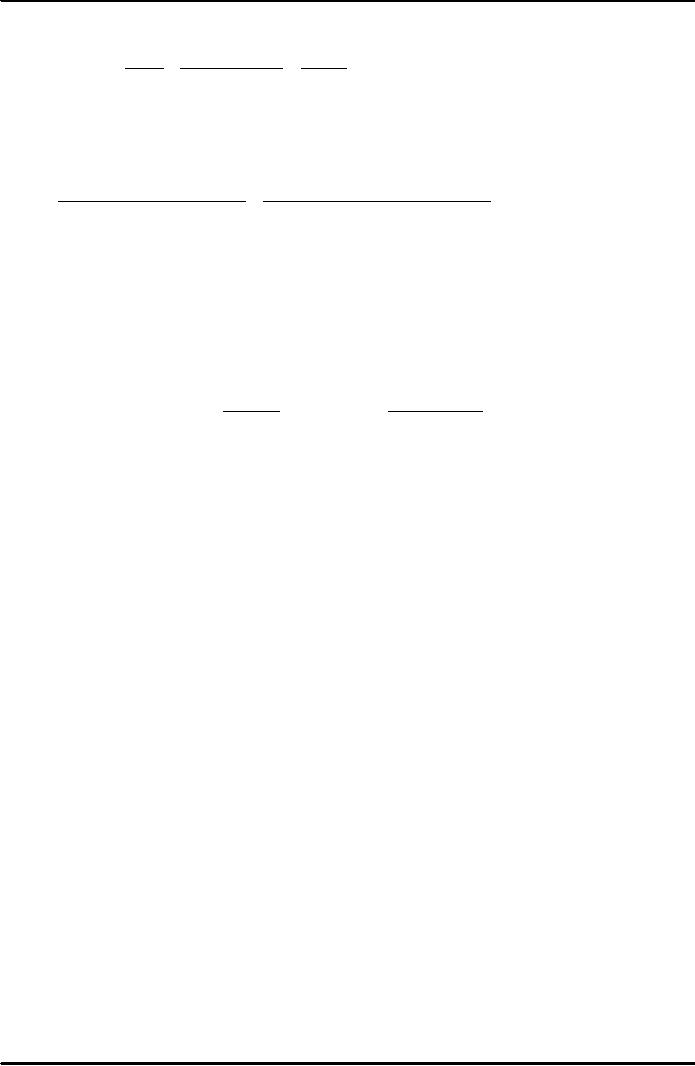
Money
& Banking MGT411
VU
One
year holding Period return
=
$93.48
-
$100
-
$.52
$6
+
=
=
-.0052
$100
$100
$100
Or
-0.52%
Generalizing,
1-year holding return
is
Yearly
Coupon Payment Change in Price of
the Bond
=
+
Price
Paid
Price
of the Bond
=
Current
Yield +
Capital
Gain (as a %)
Bond
Market and Interest
Rates
To
find out how bond
prices are determined and
why they change we need to
look at the supply
and
demand in the bond
market.
Let's
consider the market for existing
bonds at a particular time
(the stock of bonds) and
consider
prices and not interest
rates.
One
Year Zero-coupon (discount)
Bond
- P
$
100
$
100
P =
i =
or
1 +
i
P
Bond
Supply, Demand and
Equilibrium
Bond
Supply
The
Bond supply curve is the
relationship between the price and the
quantity of bonds
people
are
willing to sell, all other
things being equal.
From
the point of view of investors, the
higher the price, the more tempting it is
to sell a bond
they
currently hold.
From
the point of view of companies seeking
finance for new projects, the
higher the price at
which
they can sell bonds, the more
advantageous it is to do so.
For
a $100 one-year zero-coupon bond, the
supply will be higher at $95
than it will be at
$90,
all
other things being
equal.
Bond
Demand
The
bond demand curve is the
relationship between the price and
quantity of bonds
that
investors
demand, all other things
being equal.
As
the price falls, the reward
for holding the bond rises,
so the demand goes up
The
lower the price potential
bondholders must pay for a
fixed-dollar payment on a future
date,
the
more likely they are to buy
a bond
The
zero-coupon bond promising to pay
$100 in one year will be more
attractive at $90 than it
will
at $95, all other things
being equal.
45
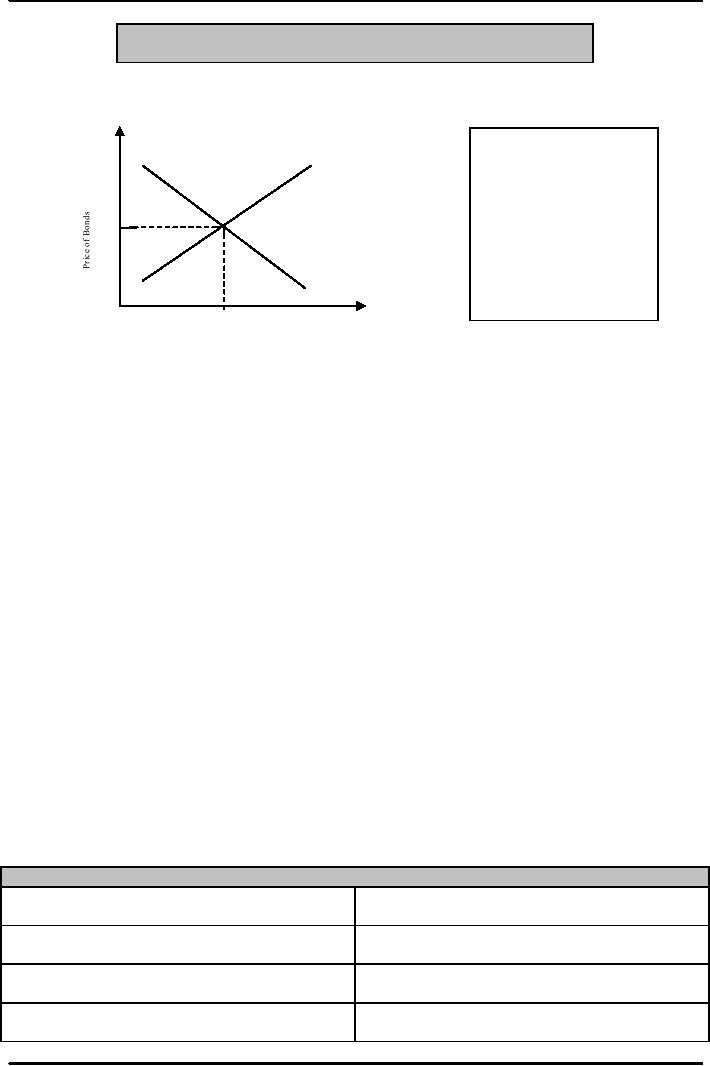
Money
& Banking MGT411
VU
Figure:
Supply, demand and
equilibrium in the bond
market
The
supply of bonds from
the
borrowers slopes up
S
and
the demand for bonds
from
the lenders slopes
down.
Equilibrium in the
E
Po
bond
market
is
determined
by
the
interaction
of supply and
demand.
D
Qo
Quantity
of Bonds
Equilibrium
in the bond market is the point at
which supply equals
demand.
If
the price is too high (above
equilibrium) the excess supply of
bonds will push the price
back
down.
If
the price is too low (below
equilibrium) the excess demand
for bonds will push it
up
Over
time the supply and demand
curves can shift, leading to
changes in the equilibrium
price
Factors
that shift Bond
Supply
Changes
in government borrowing
Any
increase in the government's borrowing
needs increases the quantity of
bonds outstanding,
shifting
the bond supply curve to the
right.
This
reduces price and increases the interest
rate on the bond.
Changes
in business conditions
Business-cycle
expansions mean more investment
opportunities, prompting firms to
increase
their
borrowing and increasing the supply of
bonds
As
business conditions improve, the
bond supply curve shifts to
the right.
This
reduces price and increases the interest
rate on the bond.
By
the same logic, weak economic
growth can lead to rising
bond prices and lower
interest rates
Changes
in expected inflation
Bond
issuers care about the real
cost of borrowing,
So
if inflation is expected to increase then
the real cost falls and the
desire to borrow
rises,
resulting
in the bond supply curve
shifting to the right
This
reduces price and increases the interest
rate on the bond.
Table:
Factors that increase Bond
Supply, lower Bond Prices,
and Raise Interest
Rates
Change
Effect
on Bond Supply, Bond Prices,
and
Interest
Rates
An
increase in the government's
desired
Bond
Supply shifts to the right,
Bond prices
expenditure
relative to its revenue
decrease
and interest rates
increase
An
improvement in general business
conditions
Bond
Supply shifts to the right,
Bond prices
decrease
and interest rates
increase
An
increase in expected inflation, reducing
the real Bond Supply shifts
to the right, Bond
prices
cost
of repayment
decrease
and interest rates
increase
46
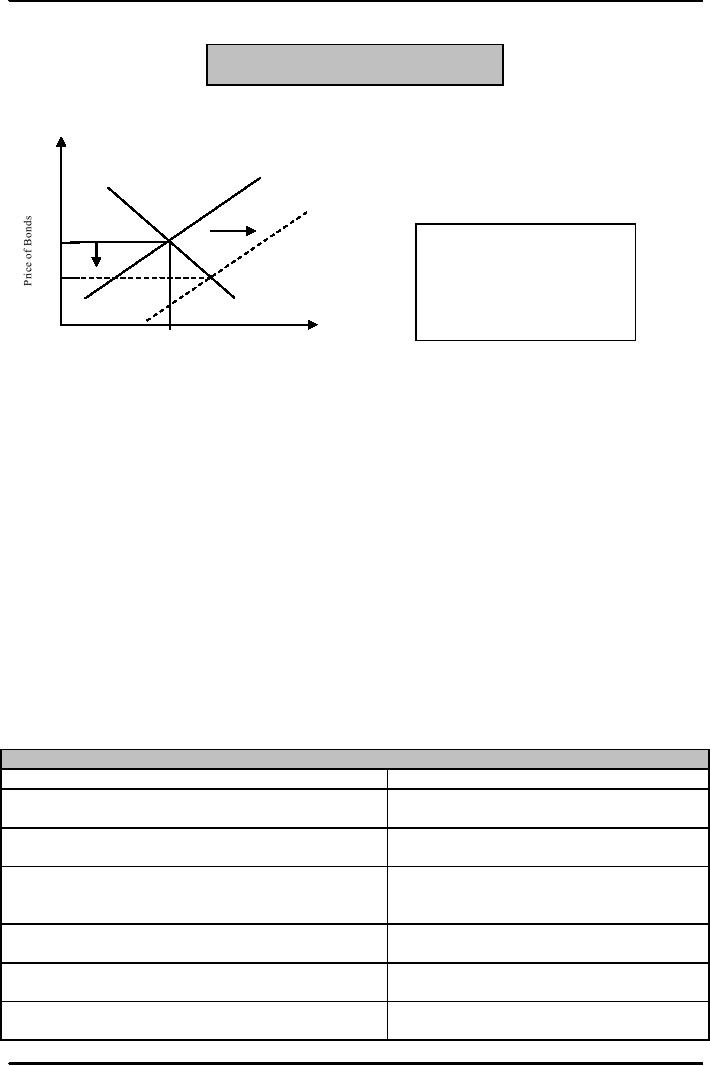
Money
& Banking MGT411
VU
Figure:
A shift in the supply of
bonds
So
S1
Eo
When
borrower's desire for
Po
funds
increases, the bond
E1
supply
curve shifts to the
P1
right,
lowering bond prices
and
raising interest rates.
D
Qo
Quantity
of Bonds
Factors
that shift Bond
Demand
Wealth
An
increase in wealth shifts the
demand for bonds to the
right as wealthier people
invest more.
This
will happen as the economy grows during an
expansion.
This
will increase Bond Prices
and lower yields.
Expected
inflation
A
fall in expected inflation shifts the
bond demand curve to the
right, increasing demand at
each
price
and lowering the yield and increasing the
Bond's price.
Expected
return on stocks and other
assets
If
the return on bonds rises
relative to the return on alternative
investments, the demand for
bonds
will rise.
This
will increase bond prices
and lower yields.
Risk
relative to alternatives
If
a bond becomes less risky
relative to alternative investments, the
demand for the bond
shifts
to
the right.
Liquidity
of bonds relative to
alternatives
When
a bond becomes more liquid
relative to alternatives, the demand
curve shifts to the
right
Table:
Factors that increase Bond
demand, raise Bond Prices,
and lower Interest Rates
Change
Effect
on Bond demand
An
increase in wealth increases
demand for all
assets,
Bond
demand shifts to the right,
Bond prices
including
bonds
increase
and interest rates
decrease
A
reduction in expected inflation makes
bonds with
Bond
demand shifts to the right,
Bond prices
fixed
nominal payments more desirable
increase
and interest rates
decrease
An
increase in expected return on the bond
relative to
Bond
demand shifts to the right,
Bond prices
the
expected return on alternatives makes
bonds more
increase
and interest rates
decrease
attractive
A
decrease in the expected future interest rate
makes
Bond
demand shifts to the right,
Bond prices
bonds
more attractive
increase
and interest rates
decrease
A
fall in the riskiness of the bond
relative to the
Bond
demand shifts to the right,
Bond prices
riskiness
of alternatives makes bonds more
attractive.
increase
and interest rates
decrease
An
increase in the liquidity of the bond
relative to the
Bond
demand shifts to the right,
Bond prices
liquidity
of alternatives makes bonds more
attractive
increase
and interest rates
decrease
47
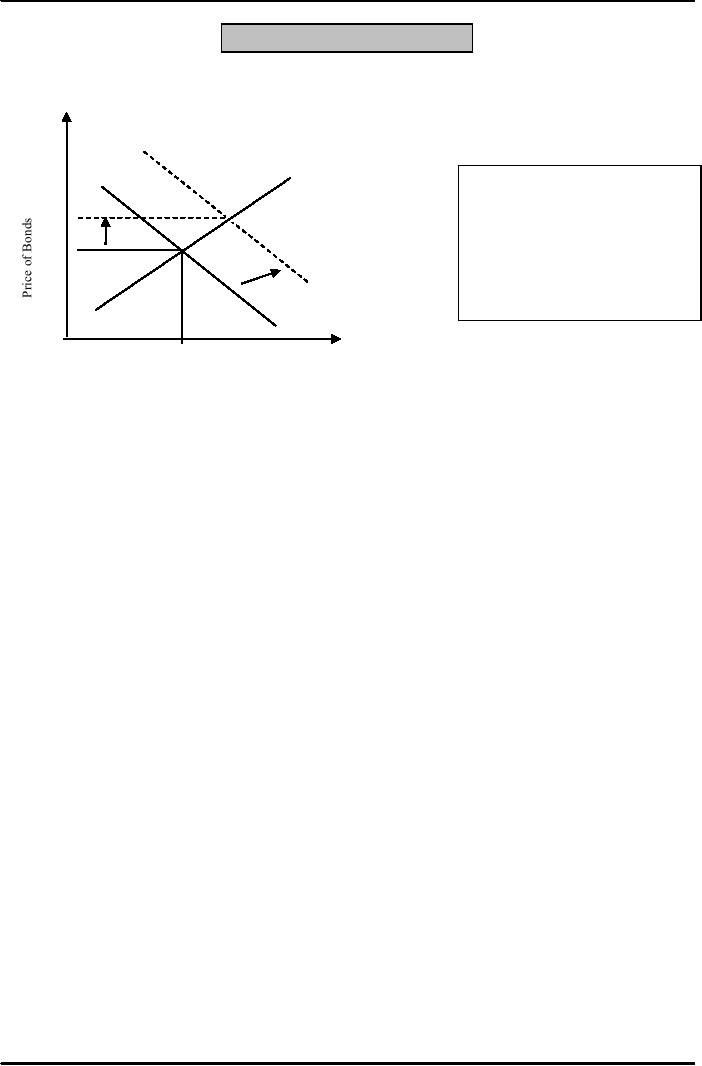
Money
& Banking MGT411
VU
Figure:
A shift in Bond Demand
S
When
there is an increase in
E1
investor's
willingness to hold
P1
bonds,
the bond demand curve
Eo
Po
shifts
to the right, increasing bond
prices
and reducing interest
rates.
D1
Do
Qo
Quantity
of Bonds
48
Table of Contents:
- TEXT AND REFERENCE MATERIAL & FIVE PARTS OF THE FINANCIAL SYSTEM
- FIVE CORE PRINCIPLES OF MONEY AND BANKING:Time has Value
- MONEY & THE PAYMENT SYSTEM:Distinctions among Money, Wealth, and Income
- OTHER FORMS OF PAYMENTS:Electronic Funds Transfer, E-money
- FINANCIAL INTERMEDIARIES:Indirect Finance, Financial and Economic Development
- FINANCIAL INSTRUMENTS & FINANCIAL MARKETS:Primarily Stores of Value
- FINANCIAL INSTITUTIONS:The structure of the financial industry
- TIME VALUE OF MONEY:Future Value, Present Value
- APPLICATION OF PRESENT VALUE CONCEPTS:Compound Annual Rates
- BOND PRICING & RISK:Valuing the Principal Payment, Risk
- MEASURING RISK:Variance, Standard Deviation, Value at Risk, Risk Aversion
- EVALUATING RISK:Deciding if a risk is worth taking, Sources of Risk
- BONDS & BONDS PRICING:Zero-Coupon Bonds, Fixed Payment Loans
- YIELD TO MATURIRY:Current Yield, Holding Period Returns
- SHIFTS IN EQUILIBRIUM IN THE BOND MARKET & RISK
- BONDS & SOURCES OF BOND RISK:Inflation Risk, Bond Ratings
- TAX EFFECT & TERM STRUCTURE OF INTEREST RATE:Expectations Hypothesis
- THE LIQUIDITY PREMIUM THEORY:Essential Characteristics of Common Stock
- VALUING STOCKS:Fundamental Value and the Dividend-Discount Model
- RISK AND VALUE OF STOCKS:The Theory of Efficient Markets
- ROLE OF FINANCIAL INTERMEDIARIES:Pooling Savings
- ROLE OF FINANCIAL INTERMEDIARIES (CONTINUED):Providing Liquidity
- BANKING:The Balance Sheet of Commercial Banks, Assets: Uses of Funds
- BALANCE SHEET OF COMMERCIAL BANKS:Bank Capital and Profitability
- BANK RISK:Liquidity Risk, Credit Risk, Interest-Rate Risk
- INTEREST RATE RISK:Trading Risk, Other Risks, The Globalization of Banking
- NON- DEPOSITORY INSTITUTIONS:Insurance Companies, Securities Firms
- SECURITIES FIRMS (Continued):Finance Companies, Banking Crisis
- THE GOVERNMENT SAFETY NET:Supervision and Examination
- THE GOVERNMENT'S BANK:The Bankers' Bank, Low, Stable Inflation
- LOW, STABLE INFLATION:High, Stable Real Growth
- MEETING THE CHALLENGE: CREATING A SUCCESSFUL CENTRAL BANK
- THE MONETARY BASE:Changing the Size and Composition of the Balance Sheet
- DEPOSIT CREATION IN A SINGLE BANK:Types of Reserves
- MONEY MULTIPLIER:The Quantity of Money (M) Depends on
- TARGET FEDERAL FUNDS RATE AND OPEN MARKET OPERATION
- WHY DO WE CARE ABOUT MONETARY AGGREGATES?The Facts about Velocity
- THE FACTS ABOUT VELOCITY:Money Growth + Velocity Growth = Inflation + Real Growth
- THE PORTFOLIO DEMAND FOR MONEY:Output and Inflation in the Long Run
- MONEY GROWTH, INFLATION, AND AGGREGATE DEMAND
- DERIVING THE MONETARY POLICY REACTION CURVE
- THE AGGREGATE DEMAND CURVE:Shifting the Aggregate Demand Curve
- THE AGGREGATE SUPPLY CURVE:Inflation Shocks
- EQUILIBRIUM AND THE DETERMINATION OF OUTPUT AND INFLATION
- SHIFTS IN POTENTIAL OUTPUT AND REAL BUSINESS CYCLE THEORY